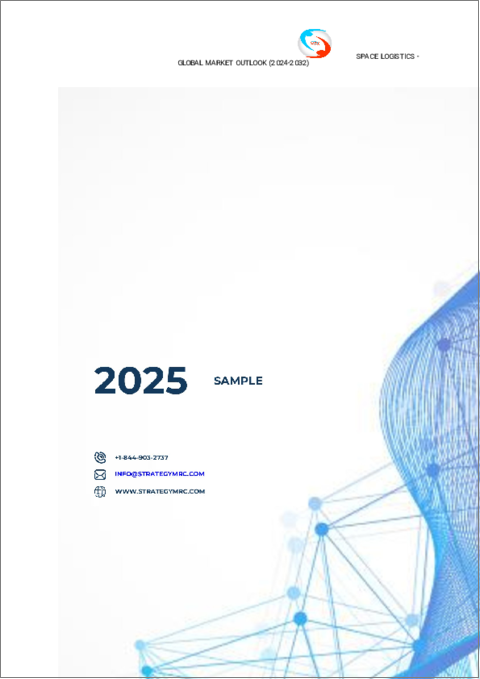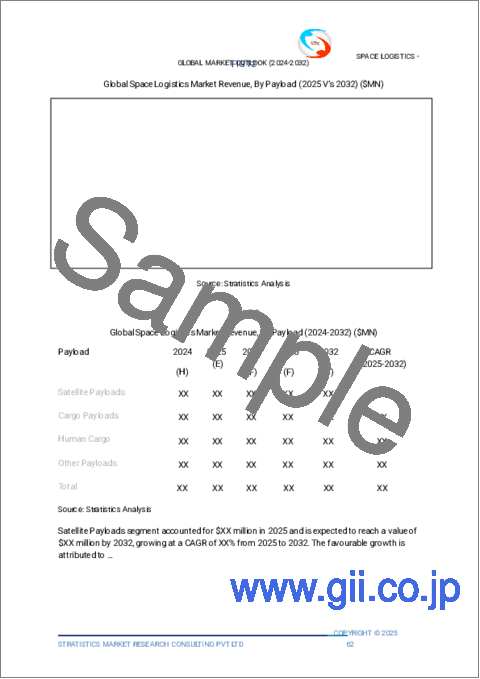|
|
市場調査レポート
商品コード
1617198
宇宙ロジスティクス市場の2030年までの予測:宇宙船タイプ別、ペイロード別、技術別、用途別、エンドユーザー別、地域別の世界分析Space Logistics Market Forecasts to 2030 - Global Analysis By Spacecraft Type (Manned Spacecraft, Unmanned Spacecraft, Reusable Spacecraft and Other Spacecraft Types), Payload, Technology, Application, End User and By Geography |
||||||
カスタマイズ可能
|
|||||||
| 宇宙ロジスティクス市場の2030年までの予測:宇宙船タイプ別、ペイロード別、技術別、用途別、エンドユーザー別、地域別の世界分析 |
|
出版日: 2024年12月11日
発行: Stratistics Market Research Consulting
ページ情報: 英文 200+ Pages
納期: 2~3営業日
|
全表示
- 概要
- 図表
- 目次
Stratistics MRCによると、世界の宇宙ロジスティクス市場は2024年に59億2,000万米ドルを占め、予測期間中のCAGRは18.2%で成長し、2030年には214億3,000万米ドルに達すると予想されています。
宇宙ロジスティクスとは、宇宙ミッションの支援に必要なリソースやシステムの計画、調整、管理を指します。宇宙ロジスティクスには、宇宙船、衛星、物資の輸送、保管、配送が含まれます。宇宙ロジスティクスは、燃料、予備部品、科学機器などの側面もカバーし、衛星の配備から惑星間探査まで、宇宙事業のタイムリーで安全な遂行を保証します。
UBSの報告書によると、500人以上の個人が登録し、2019年にニューメキシコで行われるVSSユニティでのサブオービタル宇宙旅行のチケットに約25万米ドルを支払う用意があるといいます。
宇宙ステーション運用への注目の高まり
宇宙ステーションの運用、特に国際宇宙ステーション(ISS)への注目が高まることで、定期的な補給ミッション、貨物輸送、乗組員輸送の需要が高まる。各国や民間企業が宇宙ステーションの研究を拡大するにつれて、食料、機器、燃料、科学物質の輸送など、継続的な支援サービスの必要性が高まっています。さらに、月や火星の居住施設の将来の計画は、宇宙ロジスティクスの展望を広げ、宇宙船、貨物管理、惑星間サプライチェーンの革新を促進し、市場の拡大に拍車をかけると思われます。
スペースデブリのリスク
宇宙ロジスティクスにおけるスペースデブリのリスクは、廃衛星、使用済みロケットステージ、その他の廃棄物が地球軌道上に集積することから生じる。このデブリは、貨物輸送機を含む運用中の宇宙船にとって脅威となり、衝突や損傷を引き起こす可能性があります。宇宙輸送量が増加するにつれて、デブリに関連する事故の可能性が高まり、コストのかかる緩和策の実施が不可欠となります。このようなリスクは、運用経費の増加、ミッションの遅延、規制課題の発生など、市場成長の妨げとなります。
宇宙旅行の拡大
SpaceX社、Blue Origin社、Virgin Galactic社などの企業が宇宙観光を進めるにつれて、宇宙空間での乗組員の輸送、設備、乗客の宿泊のための専門的なロジスティクスが必要となります。これには、再使用可能な宇宙船、乗客安全システム、軌道上施設の開発が含まれます。さらに、宇宙旅行への関心の高まりは宇宙インフラの革新を促し、ロジスティクス・プロバイダーが宇宙船の打ち上げ、メンテナンス、商業宇宙飛行の貨物輸送をサポートする新たな機会を生み出し、市場の成長を加速させています。
高い運用コスト
宇宙ロジスティクスの運用コストが高いのは、宇宙船の製造、ロケット打ち上げ、燃料、メンテナンスにコストがかかることに起因します。宇宙ミッション用のインフラを開発・維持するには、特に再使用可能なロケットや先進的な貨物システムに多額の投資が必要です。さらに、安全対策、規制遵守、専門的な人材も高コストの一因となっています。高コストは市場の拡大を遅らせ、特に新興の宇宙市場では利用しやすさを制限します。
COVID-19の影響
COVID-19のパンデミックは、打上げの遅延、サプライチェーンへの影響、渡航制限による物資や人員の移動の妨げにより、宇宙ロジスティクス市場を一時的に混乱させました。しかし、パンデミックは宇宙ロジスティクスのデジタルトランスフォーメーションとイノベーションを加速させ、自律システムやバーチャルコラボレーションへの依存を高めました。復興が進むにつれ、宇宙探査や衛星配備への関心が再び高まり、市場は回復しつつあります。
予測期間中、貨物補給分野が最大となる見込み
貨物補給分野は、予測期間を通じて最大の市場シェアを確保すると予測されます。貨物補給における宇宙ロジスティクスは、宇宙ステーション、衛星、その他の宇宙ミッションに必要不可欠な物資、機器、科学物質の輸送を含みます。貨物補給のロジスティクスは、長期的な宇宙探査を維持し、宇宙における人類の持続的な存在を可能にし、科学研究と衛星運用を支援するために極めて重要です。
研究機関セグメントは予測期間中最も高いCAGRが見込まれる
研究機関セグメントは、予測期間中に最も高いCAGRを示すと予測されています。研究機関における宇宙ロジスティクスは、研究目的のために科学機器、実験、材料を宇宙へ輸送することに焦点を当てています。研究機関は、精密機器、データ収集システム、その他の研究ツールを正確に届けるために宇宙ロジスティクスに依存しています。効率的なロジスティクスは、宇宙科学やその他の分野における進歩を可能にし、長期的な宇宙探査や新技術の開発を支えています。
最大のシェアを占める地域:
アジア太平洋地域は、宇宙探査、衛星配備、商業宇宙事業への投資の増加に牽引され、予測期間中に最大の市場シェアを記録すると予想されます。中国、インド、日本、韓国などの国々が、宇宙技術、衛星サービス、惑星間ミッションの進展に重点を置き、この地域の宇宙イニシアティブを主導しています。またこの地域には、再利用可能なロケットや自律型宇宙船の技術革新を推進する、成長著しい民間宇宙会社もあります。宇宙インフラと研究能力が向上するにつれて、アジア太平洋地域は世界の宇宙ロジスティクスにおける重要なプレーヤーとして台頭しつつあります。
CAGRが最も高い地域:
北米は、強力な政府投資と民間部門の技術革新に後押しされ、予測期間中最も高いCAGRを記録すると予測されます。米国は、NASAやSpaceX、Blue Origin、Rocket Labなどの非公開会社を通じて、宇宙探査、衛星配備、貨物補給ミッションの最前線にいます。この地域の強固なインフラ、再利用可能なロケットの技術的進歩、拡大する宇宙旅行構想が、効率的なロジスティクスの需要を後押ししています。
無料カスタマイズサービス:
本レポートをご購読のお客様には、以下の無料カスタマイズオプションのいずれかをご利用いただけます:
- 企業プロファイル
- 追加市場プレイヤーの包括的プロファイリング(3社まで)
- 主要企業のSWOT分析(3社まで)
- 地域セグメンテーション
- 顧客の関心に応じた主要国の市場推計・予測・CAGR(注:フィージビリティチェックによる)
- 競合ベンチマーキング
- 製品ポートフォリオ、地理的プレゼンス、戦略的提携に基づく主要企業のベンチマーキング
目次
第1章 エグゼクティブサマリー
第2章 序文
- 概要
- ステークホルダー
- 調査範囲
- 調査手法
- データマイニング
- データ分析
- データ検証
- 調査アプローチ
- 調査情報源
- 1次調査情報源
- 2次調査情報源
- 前提条件
第3章 市場動向分析
- ドライバー
- 抑制要因
- 機会
- 脅威
- 技術分析
- 用途分析
- エンドユーザー分析
- 新興市場
- COVID-19の影響
第4章 ポーターのファイブフォース分析
- 供給企業の交渉力
- 買い手の交渉力
- 代替品の脅威
- 新規参入業者の脅威
- 競争企業間の敵対関係
第5章 世界の宇宙ロジスティクス市場:宇宙船タイプ別
- 有人宇宙船
- 無人宇宙船
- 再利用可能な宇宙船
- その他の宇宙船タイプ
第6章 世界の宇宙ロジスティクス市場:ペイロード別
- 衛星ペイロード
- 貨物積載量
- 人間の貨物
- その他のペイロード
第7章 世界の宇宙ロジスティクス市場:技術別
- 先進推進システム
- ロボット工学と自動化
- 人工知能
- データ分析
- その他の技術
第8章 世界の宇宙ロジスティクス市場:用途別
- 貨物補給
- 宇宙観光物流
- 宇宙船の燃料補給とメンテナンス
- 軌道インフラ開発
- 宇宙研究開発
- 月と火星の物流
- その他の用途
第9章 世界の宇宙ロジスティクス市場:エンドユーザー別
- 政府機関
- 商業企業
- 軍事組織
- 通信
- 調査機関
- その他のエンドユーザー
第10章 世界の宇宙ロジスティクス市場:地域別
- 北米
- 米国
- カナダ
- メキシコ
- 欧州
- ドイツ
- 英国
- イタリア
- フランス
- スペイン
- その他欧州
- アジア太平洋
- 日本
- 中国
- インド
- オーストラリア
- ニュージーランド
- 韓国
- その他アジア太平洋
- 南米
- アルゼンチン
- ブラジル
- チリ
- その他南米
- 中東・アフリカ
- サウジアラビア
- アラブ首長国連邦
- カタール
- 南アフリカ
- その他中東とアフリカ
第11章 主な発展
- 契約、パートナーシップ、コラボレーション、合弁事業
- 買収と合併
- 新製品発売
- 事業拡大
- その他の主要戦略
第12章 企業プロファイリング
- SpaceX
- Northrop Grumman Innovation Systems
- Lockheed Martin
- Boeing
- Thales Alenia Space
- Airbus Defence and Space
- Impulso.Space
- Spaceflight Industries
- Sierra Nevada Corporation
- Arianespace
- Blue Origin
- Orbital Sciences Corporation
- Rocket Lab
- Astroscale
- ExPace
- Iridium Communications
- Maxar Technologies
List of Tables
- Table 1 Global Space Logistics Market Outlook, By Region (2022-2030) ($MN)
- Table 2 Global Space Logistics Market Outlook, By Spacecraft Type (2022-2030) ($MN)
- Table 3 Global Space Logistics Market Outlook, By Manned Spacecraft (2022-2030) ($MN)
- Table 4 Global Space Logistics Market Outlook, By Unmanned Spacecraft (2022-2030) ($MN)
- Table 5 Global Space Logistics Market Outlook, By Reusable Spacecraft (2022-2030) ($MN)
- Table 6 Global Space Logistics Market Outlook, By Other Spacecraft Types (2022-2030) ($MN)
- Table 7 Global Space Logistics Market Outlook, By Payload (2022-2030) ($MN)
- Table 8 Global Space Logistics Market Outlook, By Satellite Payloads (2022-2030) ($MN)
- Table 9 Global Space Logistics Market Outlook, By Cargo Payloads (2022-2030) ($MN)
- Table 10 Global Space Logistics Market Outlook, By Human Cargo (2022-2030) ($MN)
- Table 11 Global Space Logistics Market Outlook, By Other Payloads (2022-2030) ($MN)
- Table 12 Global Space Logistics Market Outlook, By Technology (2022-2030) ($MN)
- Table 13 Global Space Logistics Market Outlook, By Advanced Propulsion Systems (2022-2030) ($MN)
- Table 14 Global Space Logistics Market Outlook, By Robotics & Automation (2022-2030) ($MN)
- Table 15 Global Space Logistics Market Outlook, By Artificial Intelligence (2022-2030) ($MN)
- Table 16 Global Space Logistics Market Outlook, By Data Analytics (2022-2030) ($MN)
- Table 17 Global Space Logistics Market Outlook, By Other Technologies (2022-2030) ($MN)
- Table 18 Global Space Logistics Market Outlook, By Application (2022-2030) ($MN)
- Table 19 Global Space Logistics Market Outlook, By Cargo Resupply (2022-2030) ($MN)
- Table 20 Global Space Logistics Market Outlook, By Space Tourism Logistics (2022-2030) ($MN)
- Table 21 Global Space Logistics Market Outlook, By Spacecraft Refuelling & Maintenance (2022-2030) ($MN)
- Table 22 Global Space Logistics Market Outlook, By Orbital Infrastructure Development (2022-2030) ($MN)
- Table 23 Global Space Logistics Market Outlook, By Space Research & Development (2022-2030) ($MN)
- Table 24 Global Space Logistics Market Outlook, By Lunar & Mars Logistics (2022-2030) ($MN)
- Table 25 Global Space Logistics Market Outlook, By Other Applications (2022-2030) ($MN)
- Table 26 Global Space Logistics Market Outlook, By End User (2022-2030) ($MN)
- Table 27 Global Space Logistics Market Outlook, By Government Agencies (2022-2030) ($MN)
- Table 28 Global Space Logistics Market Outlook, By Commercial Enterprises (2022-2030) ($MN)
- Table 29 Global Space Logistics Market Outlook, By Military Organizations (2022-2030) ($MN)
- Table 30 Global Space Logistics Market Outlook, By Telecommunications (2022-2030) ($MN)
- Table 31 Global Space Logistics Market Outlook, By Research Institutions (2022-2030) ($MN)
- Table 32 Global Space Logistics Market Outlook, By Other End Users (2022-2030) ($MN)
Note: Tables for North America, Europe, APAC, South America, and Middle East & Africa Regions are also represented in the same manner as above.
According to Stratistics MRC, the Global Space Logistics Market is accounted for $5.92 billion in 2024 and is expected to reach $21.43 billion by 2030 growing at a CAGR of 18.2% during the forecast period. Space logistics refers to the planning, coordination, and management of resources and systems required to support space missions. It involves the transportation, storage, and delivery of spacecraft, satellites, and supplies to and from space. Space logistics also covers aspects such as fuel, spare parts, and scientific instruments, ensuring the timely and safe execution of space operations, from satellite deployment to interplanetary exploration.
According to UBS report, more than 500 individuals signed up, each prepared to pay roughly $250,000 for tickets to suborbital space journeys on the VSS Unity in New Mexico in 2019.
Market Dynamics:
Driver:
Increased focus on space station operations
Increased focus on space station operations, particularly the International Space Station (ISS) drives demand for regular resupply missions, cargo delivery, and crew transportation. As countries and private entities expand space station research, the need for continuous support services-such as sending food, equipment, fuel, and scientific materials-intensifies. Furthermore, future plans for lunar and Mars habitats will increase the scope for space logistics, promoting innovations in spacecraft, cargo management, and interplanetary supply chains, fueling market expansion.
Restraint:
Risk of space debris
The risk of space debris in space logistics arises from defunct satellites, spent rocket stages, and other discarded objects accumulating in Earth's orbit. This debris poses a threat to operational spacecraft, including cargo transport vehicles, potentially causing collisions or damage. As space traffic increases, the likelihood of debris-related accidents rises, making it essential to implement costly mitigation measures. This risk hampers market growth by increasing operational expenses, delaying missions, and prompting regulatory challenges.
Opportunity:
Expansion of space tourism
As companies like SpaceX, Blue Origin, and Virgin Galactic advance in space tourism, they require specialized logistics for crew transport, equipment, and passenger accommodations in space. This includes the development of reusable spacecraft, passenger safety systems, and in-orbit facilities. Additionally, the growing interest in space tourism drives innovations in space infrastructure, creating new opportunities for logistics providers to support spacecraft launches, maintenance, and cargo delivery for commercial space flights, which thereby accelerates the market growth.
Threat:
High operational costs
High operational costs in space logistics stem from the expensive nature of spacecraft manufacturing, rocket launches, fuel, and maintenance. Developing and maintaining infrastructure for space missions requires significant investment, especially for reusable launch vehicles and advanced cargo systems. Additionally, safety measures, regulatory compliance, and specialized personnel contribute to the high costs. The high costs slow down market expansion and limit accessibility, particularly in emerging space markets.
Covid-19 Impact
The covid-19 pandemic temporarily disrupted the space logistics market by delaying launches, impacting supply chains, and hindering the movement of materials and personnel due to travel restrictions. However, the pandemic accelerated digital transformation and innovation in space logistics, with increased reliance on autonomous systems and virtual collaboration. As recovery progresses, the market is rebounding, with renewed interest in space exploration and satellite deployment.
The cargo resupply segment is expected to be the largest during the forecast period
The cargo resupply segment is predicted to secure the largest market share throughout the forecast period. Space logistics in cargo resupply involves the transportation of essential supplies, equipment, and scientific materials to space stations, satellites, and other space missions. Cargo resupply logistics are crucial for maintaining long-term space exploration, enabling sustained human presence in space and supporting scientific research and satellite operations.
The research institutions segment is expected to have the highest CAGR during the forecast period
The research institutions segment is anticipated to witness the highest CAGR during the forecast period. Space logistics in research institutions focuses on transporting scientific equipment, experiments, and materials to space for research purposes. Research institutions rely on space logistics for precise delivery of sensitive instruments, data collection systems, and other research tools. Efficient logistics enable advancements in space science and other fields, supporting long-term space exploration and the development of new technologies.
Region with largest share:
Asia Pacific is expected to register the largest market share during the forecast period driven by increasing investments in space exploration, satellite deployment, and commercial space ventures. Countries like China, India, Japan, and South Korea are leading the region's space initiatives, with a focus on advancing space technology, satellite services, and interplanetary missions. The region is also home to growing private space companies, which are pushing innovation in reusable rockets and autonomous spacecraft. As space infrastructure and research capabilities improve, Asia Pacific is emerging as a key player in global space logistics.
Region with highest CAGR:
North America is projected to witness the highest CAGR over the forecast period fuelled by strong government investment and private sector innovation. The United States, through NASA and private companies like SpaceX, Blue Origin, and Rocket Lab, is at the forefront of space exploration, satellite deployment, and cargo resupply missions. The region's robust infrastructure, technological advancements in reusable rockets, and expanding space tourism initiatives are boosting the demand for efficient logistics.
Key players in the market
Some of the key players profiled in the Space Logistics Market include SpaceX, Northrop Grumman Innovation Systems, Lockheed Martin, Boeing, Thales Alenia Space, Airbus Defence and Space, Impulso.Space, Spaceflight Industries, Sierra Nevada Corporation, Arianespace, Blue Origin, Orbital Sciences Corporation, Rocket Lab, Astroscale, ExPace, Iridium Communications and Maxar Technologies.
Key Developments:
In November 2024, Impulso.Space USA Corp. signed a multi-mission launch services contract with D-Orbit, reinforcing a longstanding collaboration that continues to elevate the scope of end-to-end space solutions. This agreement also includes multiple satellite launches as part of upcoming SpaceX Transporter Rideshare missions, with Impulso.Space providing comprehensive mission management services, including all logistical and technical support, from their state-of-the-art facility in Florida.
In February 2022, Northrop Grumman launched the mission robotic vehicle and mission extension pods. These technologies are designed to extend the life of satellites in orbit, reducing the need for new satellites and providing a sustainable, cost-effective solution for satellite maintenance.
Spacecraft Types Covered:
- Manned Spacecraft
- Unmanned Spacecraft
- Reusable Spacecraft
- Other Spacecraft Types
Payloads Covered:
- Satellite Payloads
- Cargo Payloads
- Human Cargo
- Other Payloads
Technologies Covered:
- Advanced Propulsion Systems
- Robotics & Automation
- Artificial Intelligence
- Data Analytics
- Other Technologies
Applications Covered:
- Cargo Resupply
- Space Tourism Logistics
- Spacecraft Refuelling & Maintenance
- Orbital Infrastructure Development
- Space Research & Development
- Lunar & Mars Logistics
- Other Applications
End Users Covered:
- Government Agencies
- Commercial Enterprises
- Military Organizations
- Telecommunications
- Research Institutions
- Other End Users
Regions Covered:
- North America
- US
- Canada
- Mexico
- Europe
- Germany
- UK
- Italy
- France
- Spain
- Rest of Europe
- Asia Pacific
- Japan
- China
- India
- Australia
- New Zealand
- South Korea
- Rest of Asia Pacific
- South America
- Argentina
- Brazil
- Chile
- Rest of South America
- Middle East & Africa
- Saudi Arabia
- UAE
- Qatar
- South Africa
- Rest of Middle East & Africa
What our report offers:
- Market share assessments for the regional and country-level segments
- Strategic recommendations for the new entrants
- Covers Market data for the years 2022, 2023, 2024, 2026, and 2030
- Market Trends (Drivers, Constraints, Opportunities, Threats, Challenges, Investment Opportunities, and recommendations)
- Strategic recommendations in key business segments based on the market estimations
- Competitive landscaping mapping the key common trends
- Company profiling with detailed strategies, financials, and recent developments
- Supply chain trends mapping the latest technological advancements
Free Customization Offerings:
All the customers of this report will be entitled to receive one of the following free customization options:
- Company Profiling
- Comprehensive profiling of additional market players (up to 3)
- SWOT Analysis of key players (up to 3)
- Regional Segmentation
- Market estimations, Forecasts and CAGR of any prominent country as per the client's interest (Note: Depends on feasibility check)
- Competitive Benchmarking
- Benchmarking of key players based on product portfolio, geographical presence, and strategic alliances
Table of Contents
1 Executive Summary
2 Preface
- 2.1 Abstract
- 2.2 Stake Holders
- 2.3 Research Scope
- 2.4 Research Methodology
- 2.4.1 Data Mining
- 2.4.2 Data Analysis
- 2.4.3 Data Validation
- 2.4.4 Research Approach
- 2.5 Research Sources
- 2.5.1 Primary Research Sources
- 2.5.2 Secondary Research Sources
- 2.5.3 Assumptions
3 Market Trend Analysis
- 3.1 Introduction
- 3.2 Drivers
- 3.3 Restraints
- 3.4 Opportunities
- 3.5 Threats
- 3.6 Technology Analysis
- 3.7 Application Analysis
- 3.8 End User Analysis
- 3.9 Emerging Markets
- 3.10 Impact of Covid-19
4 Porters Five Force Analysis
- 4.1 Bargaining power of suppliers
- 4.2 Bargaining power of buyers
- 4.3 Threat of substitutes
- 4.4 Threat of new entrants
- 4.5 Competitive rivalry
5 Global Space Logistics Market, By Spacecraft Type
- 5.1 Introduction
- 5.2 Manned Spacecraft
- 5.3 Unmanned Spacecraft
- 5.4 Reusable Spacecraft
- 5.5 Other Spacecraft Types
6 Global Space Logistics Market, By Payload
- 6.1 Introduction
- 6.2 Satellite Payloads
- 6.3 Cargo Payloads
- 6.4 Human Cargo
- 6.5 Other Payloads
7 Global Space Logistics Market, By Technology
- 7.1 Introduction
- 7.2 Advanced Propulsion Systems
- 7.3 Robotics & Automation
- 7.4 Artificial Intelligence
- 7.5 Data Analytics
- 7.6 Other Technologies
8 Global Space Logistics Market, By Application
- 8.1 Introduction
- 8.2 Cargo Resupply
- 8.3 Space Tourism Logistics
- 8.4 Spacecraft Refuelling & Maintenance
- 8.5 Orbital Infrastructure Development
- 8.6 Space Research & Development
- 8.7 Lunar & Mars Logistics
- 8.8 Other Applications
9 Global Space Logistics Market, By End User
- 9.1 Introduction
- 9.2 Government Agencies
- 9.3 Commercial Enterprises
- 9.4 Military Organizations
- 9.5 Telecommunications
- 9.6 Research Institutions
- 9.7 Other End Users
10 Global Space Logistics Market, By Geography
- 10.1 Introduction
- 10.2 North America
- 10.2.1 US
- 10.2.2 Canada
- 10.2.3 Mexico
- 10.3 Europe
- 10.3.1 Germany
- 10.3.2 UK
- 10.3.3 Italy
- 10.3.4 France
- 10.3.5 Spain
- 10.3.6 Rest of Europe
- 10.4 Asia Pacific
- 10.4.1 Japan
- 10.4.2 China
- 10.4.3 India
- 10.4.4 Australia
- 10.4.5 New Zealand
- 10.4.6 South Korea
- 10.4.7 Rest of Asia Pacific
- 10.5 South America
- 10.5.1 Argentina
- 10.5.2 Brazil
- 10.5.3 Chile
- 10.5.4 Rest of South America
- 10.6 Middle East & Africa
- 10.6.1 Saudi Arabia
- 10.6.2 UAE
- 10.6.3 Qatar
- 10.6.4 South Africa
- 10.6.5 Rest of Middle East & Africa
11 Key Developments
- 11.1 Agreements, Partnerships, Collaborations and Joint Ventures
- 11.2 Acquisitions & Mergers
- 11.3 New Product Launch
- 11.4 Expansions
- 11.5 Other Key Strategies
12 Company Profiling
- 12.1 SpaceX
- 12.2 Northrop Grumman Innovation Systems
- 12.3 Lockheed Martin
- 12.4 Boeing
- 12.5 Thales Alenia Space
- 12.6 Airbus Defence and Space
- 12.7 Impulso.Space
- 12.8 Spaceflight Industries
- 12.9 Sierra Nevada Corporation
- 12.10 Arianespace
- 12.11 Blue Origin
- 12.12 Orbital Sciences Corporation
- 12.13 Rocket Lab
- 12.14 Astroscale
- 12.15 ExPace
- 12.16 Iridium Communications
- 12.17 Maxar Technologies






